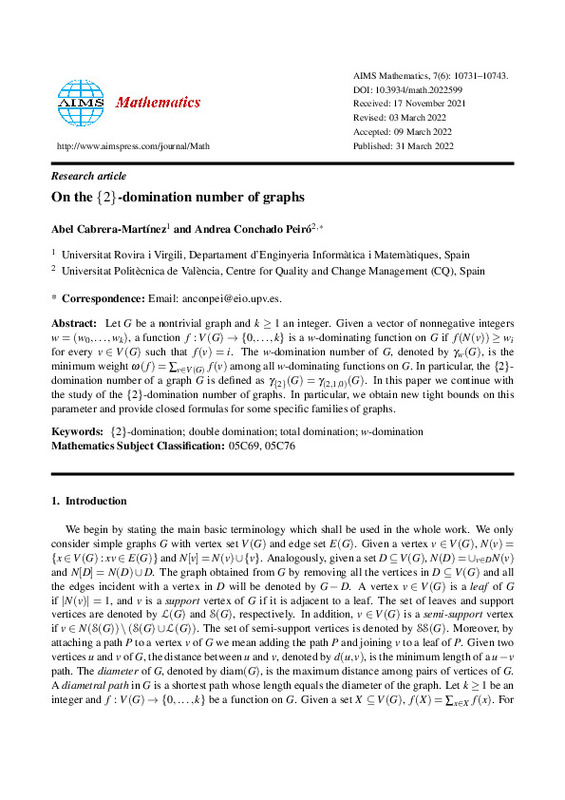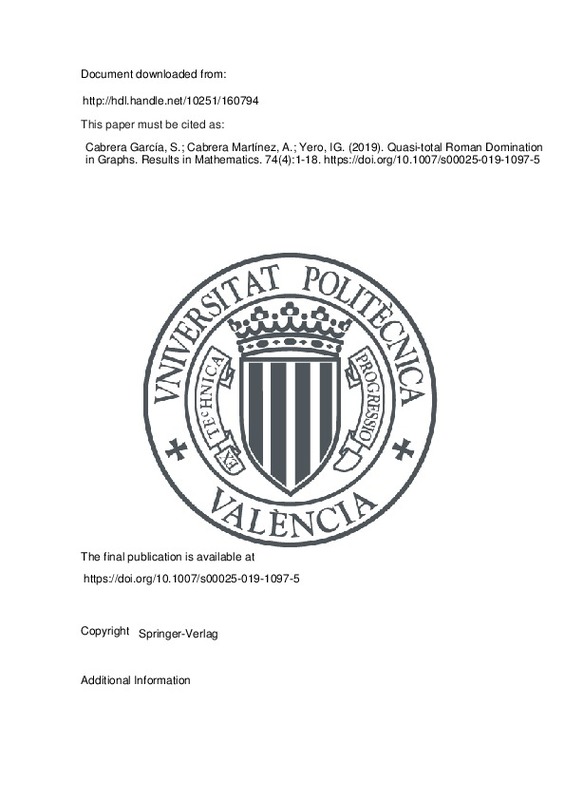JavaScript is disabled for your browser. Some features of this site may not work without it.
Buscar en RiuNet
Listar
Mi cuenta
Estadísticas
Ayuda RiuNet
Admin. UPV
Further Results on the Total Roman Domination in Graphs
Mostrar el registro sencillo del ítem
Ficheros en el ítem
| dc.contributor.author | Cabrera Martínez, Abel
|
es_ES |
| dc.contributor.author | Cabrera García, Suitberto
|
es_ES |
| dc.contributor.author | Carrión García, Andrés
|
es_ES |
| dc.date.accessioned | 2021-02-24T04:31:56Z | |
| dc.date.available | 2021-02-24T04:31:56Z | |
| dc.date.issued | 2020-03 | es_ES |
| dc.identifier.uri | http://hdl.handle.net/10251/162249 | |
| dc.description.abstract | [EN] Let G be a graph without isolated vertices. A function f:V(G)-> {0,1,2} is a total Roman dominating function on G if every vertex v is an element of V(G) for which f(v)=0 is adjacent to at least one vertex u is an element of V(G) such that f(u)=2 , and if the subgraph induced by the set {v is an element of V(G):f(v)>= 1} has no isolated vertices. The total Roman domination number of G, denoted gamma tR(G) , is the minimum weight omega (f)=Sigma v is an element of V(G)f(v) among all total Roman dominating functions f on G. In this article we obtain new tight lower and upper bounds for gamma tR(G) which improve the well-known bounds 2 gamma (G)<= gamma tR(G)<= 3 gamma (G) , where gamma (G) represents the classical domination number. In addition, we characterize the graphs that achieve equality in the previous lower bound and we give necessary conditions for the graphs which satisfy the equality in the upper bound above. | es_ES |
| dc.language | Inglés | es_ES |
| dc.publisher | MDPI AG | es_ES |
| dc.relation.ispartof | Mathematics | es_ES |
| dc.rights | Reconocimiento (by) | es_ES |
| dc.subject | Total Roman domination | es_ES |
| dc.subject | Roman domination | es_ES |
| dc.subject | Semitotal domination | es_ES |
| dc.subject | Domination | es_ES |
| dc.subject.classification | ESTADISTICA E INVESTIGACION OPERATIVA | es_ES |
| dc.title | Further Results on the Total Roman Domination in Graphs | es_ES |
| dc.type | Artículo | es_ES |
| dc.identifier.doi | 10.3390/math8030349 | es_ES |
| dc.rights.accessRights | Abierto | es_ES |
| dc.contributor.affiliation | Universitat Politècnica de València. Departamento de Estadística e Investigación Operativa Aplicadas y Calidad - Departament d'Estadística i Investigació Operativa Aplicades i Qualitat | es_ES |
| dc.description.bibliographicCitation | Cabrera Martínez, A.; Cabrera García, S.; Carrión García, A. (2020). Further Results on the Total Roman Domination in Graphs. Mathematics. 8(3):1-8. https://doi.org/10.3390/math8030349 | es_ES |
| dc.description.accrualMethod | S | es_ES |
| dc.relation.publisherversion | https://doi.org/10.3390/math8030349 | es_ES |
| dc.description.upvformatpinicio | 1 | es_ES |
| dc.description.upvformatpfin | 8 | es_ES |
| dc.type.version | info:eu-repo/semantics/publishedVersion | es_ES |
| dc.description.volume | 8 | es_ES |
| dc.description.issue | 3 | es_ES |
| dc.identifier.eissn | 2227-7390 | es_ES |
| dc.relation.pasarela | S\413492 | es_ES |
| dc.description.references | Henning, M. A. (2009). A survey of selected recent results on total domination in graphs. Discrete Mathematics, 309(1), 32-63. doi:10.1016/j.disc.2007.12.044 | es_ES |
| dc.description.references | Henning, M. A., & Yeo, A. (2013). Total Domination in Graphs. Springer Monographs in Mathematics. doi:10.1007/978-1-4614-6525-6 | es_ES |
| dc.description.references | Henning, M. A., & Marcon, A. J. (2016). Semitotal Domination in Claw-Free Cubic Graphs. Annals of Combinatorics, 20(4), 799-813. doi:10.1007/s00026-016-0331-z | es_ES |
| dc.description.references | Henning, M. . A., & Marcon, A. J. (2016). Vertices contained in all or in no minimum semitotal dominating set of a tree. Discussiones Mathematicae Graph Theory, 36(1), 71. doi:10.7151/dmgt.1844 | es_ES |
| dc.description.references | Henning, M. A., & Pandey, A. (2019). Algorithmic aspects of semitotal domination in graphs. Theoretical Computer Science, 766, 46-57. doi:10.1016/j.tcs.2018.09.019 | es_ES |
| dc.description.references | Cockayne, E. J., Dreyer, P. A., Hedetniemi, S. M., & Hedetniemi, S. T. (2004). Roman domination in graphs. Discrete Mathematics, 278(1-3), 11-22. doi:10.1016/j.disc.2003.06.004 | es_ES |
| dc.description.references | Stewart, I. (1999). Defend the Roman Empire! Scientific American, 281(6), 136-138. doi:10.1038/scientificamerican1299-136 | es_ES |
| dc.description.references | Chambers, E. W., Kinnersley, B., Prince, N., & West, D. B. (2009). Extremal Problems for Roman Domination. SIAM Journal on Discrete Mathematics, 23(3), 1575-1586. doi:10.1137/070699688 | es_ES |
| dc.description.references | Favaron, O., Karami, H., Khoeilar, R., & Sheikholeslami, S. M. (2009). On the Roman domination number of a graph. Discrete Mathematics, 309(10), 3447-3451. doi:10.1016/j.disc.2008.09.043 | es_ES |
| dc.description.references | Liu, C.-H., & Chang, G. J. (2012). Upper bounds on Roman domination numbers of graphs. Discrete Mathematics, 312(7), 1386-1391. doi:10.1016/j.disc.2011.12.021 | es_ES |
| dc.description.references | González, Y., & Rodríguez-Velázquez, J. (2013). Roman domination in Cartesian product graphs and strong product graphs. Applicable Analysis and Discrete Mathematics, 7(2), 262-274. doi:10.2298/aadm130813017g | es_ES |
| dc.description.references | Liu, C.-H., & Chang, G. J. (2012). Roman domination on strongly chordal graphs. Journal of Combinatorial Optimization, 26(3), 608-619. doi:10.1007/s10878-012-9482-y | es_ES |
| dc.description.references | Ahangar Abdollahzadeh, H., Henning, M., Samodivkin, V., & Yero, I. (2016). Total Roman domination in graphs. Applicable Analysis and Discrete Mathematics, 10(2), 501-517. doi:10.2298/aadm160802017a | es_ES |
| dc.description.references | Amjadi, J., Sheikholeslami, S. M., & Soroudi, M. (2019). On the total Roman domination in trees. Discussiones Mathematicae Graph Theory, 39(2), 519. doi:10.7151/dmgt.2099 | es_ES |
| dc.description.references | Cabrera Martínez, A., Montejano, L. P., & Rodríguez-Velázquez, J. A. (2019). Total Weak Roman Domination in Graphs. Symmetry, 11(6), 831. doi:10.3390/sym11060831 | es_ES |











